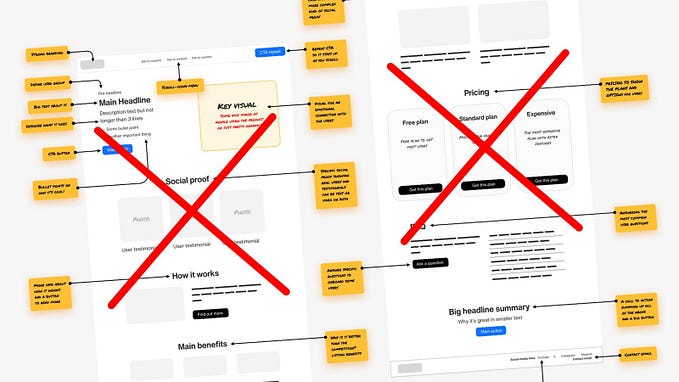Deceptive UX as an accelerant for transformation
How manipulative design can drive digital platforms toward collapse and reinvention.

Designers constantly juggle the challenge of balancing user-centric design with business goals. While good UX focuses on creating seamless, intuitive experiences, Deceptive UX emerges when those same skills are utilized to manipulate user behavior.
Tactics like hidden fees, misleading buttons, subscription traps, and infinite scrolling guide users toward unintended actions to maximize engagement and profit. These practices flourish in a capitalist system where platforms compete to extract the most value from user behavior.
Although companies justify Deceptive UX as necessary to achieve business objectives, these tactics produce associated costs. The erosion of user trust and increasing frustration often emerge, causing platforms to engage in a cycle of short-term gains and long-term losses. Deceptive practices invite regulatory intervention, leading to patchwork fixes that frequently spawn new manipulative tactics.
This vicious cycle feels unsustainable, prompting an unsettling question: What if attempts to fix Deceptive UX are destined to fail?
Accelerationism and the Limits of Reform
A controversial philosophical concept known as accelerationism argues that systems only change under extreme pressure — moderate reforms merely delay inevitable collapse. In this context, Deceptive UX is not a problem to solve—it’s a force accelerating the contradictions within digital capitalism.
Some of these system contradictions include promising autonomy while controlling users, driving profit at the cost of trust, and optimizing engagement while causing burnout.
For example, platforms such as Instagram and TikTok rely on infinite scrolling to hook users, while services such as Amazon Prime complicate cancellations to trap consumers. As users become aware of these Deceptive UX tactics, frustration deepens, eroding trust.
Disillusioned users disengage from such platforms, seek alternatives, or abandon digital spaces altogether. This disengagement reflects a larger fracture within the digital ecosystem, aligning with accelerationism’s strategy of pushing systems toward collapse.
Rather than a glitch in the system, disruption becomes a necessary step toward change — only through the exhaustion of manipulative systems can something new emerge.
Accelerationism suggests that failure isn’t an endpoint but a necessary catalyst for reinvention. As platforms collapse under their contradictions, they create space for new economic models, governance structures, or decentralized networks to emerge. Deceptive UX, in this framework, isn’t just a symptom of a broken system — it’s a mechanism accelerating digital capitalism toward its breaking point.
The idea of embracing Deceptive UX may seem unethical. However, according to accelerationism, ethical objections to disruption and manipulation are misplaced because collapse and chaos are necessary steps toward meaningful change.
Rather than viewing such anarchy as destructive, accelerationism frames it as a transitional phase — a breaking down of obsolete systems to make space for new, potentially more just structures. In this view, resisting the utilization of manipulation delays the inevitable and hinders progress, as only through systemic failure can transformation take root.
The Risks and Uncertainties of Accelerationism
While accelerationism offers a bold path to systemic change, it carries significant risks. The assumption that collapse will lead to positive transformation is far from guaranteed.
System breakdowns could spiral into social fragmentation, economic instability, or deeper inequality, with no assurance that better structures will emerge. During the transition, users may face alienation and chaos, leaving them without reliable alternatives or support.
Accelerationism also dismisses the potential value of gradual reform, overlooking the possibility that incremental change could reduce harm without the cost of collapse. Its all-or-nothing approach assumes that new systems will inevitably be more just—but this is an optimistic gamble, not a certainty.
Furthermore, framing destructive practices like Deceptive UX as tools for progress raises ethical concerns beyond the self-evident. Pushing systems to failure perpetuates harm, blurring the line between necessary disruption and reckless exploitation. Vulnerable users and marginalized communities often bear the brunt of these failures, suffering in the name of change.
Ultimately, the philosophy of accelerationism rests on uncertain outcomes. While collapse might create space for innovation, it could just as easily result in chaos with no clear path forward, relying on the hope that society can address its underlying issues once the band-aid is ripped off.
Balancing Risk and Reinvention
Accelerationism presents a radical approach, yet it offers a rational critique. In a complex system like digital capitalism, incremental changes prove insufficient in advancing toward a more equitable structure.
It is imperative for society to grapple with the question of whether the natural manipulation of tactics such as Deceptive UX can drive rapid enough change, and whether the potential risks of collapse are justifiable for the uncertain promise of transformation.
As economic systems such as digital capitalism buckle under their contradictions, the challenge will be to harness that disruption productively — creating new models that move beyond exploitation without falling into disorder, offering a hopeful path forward.
Don’t miss out! Join my email list and receive the latest content.







